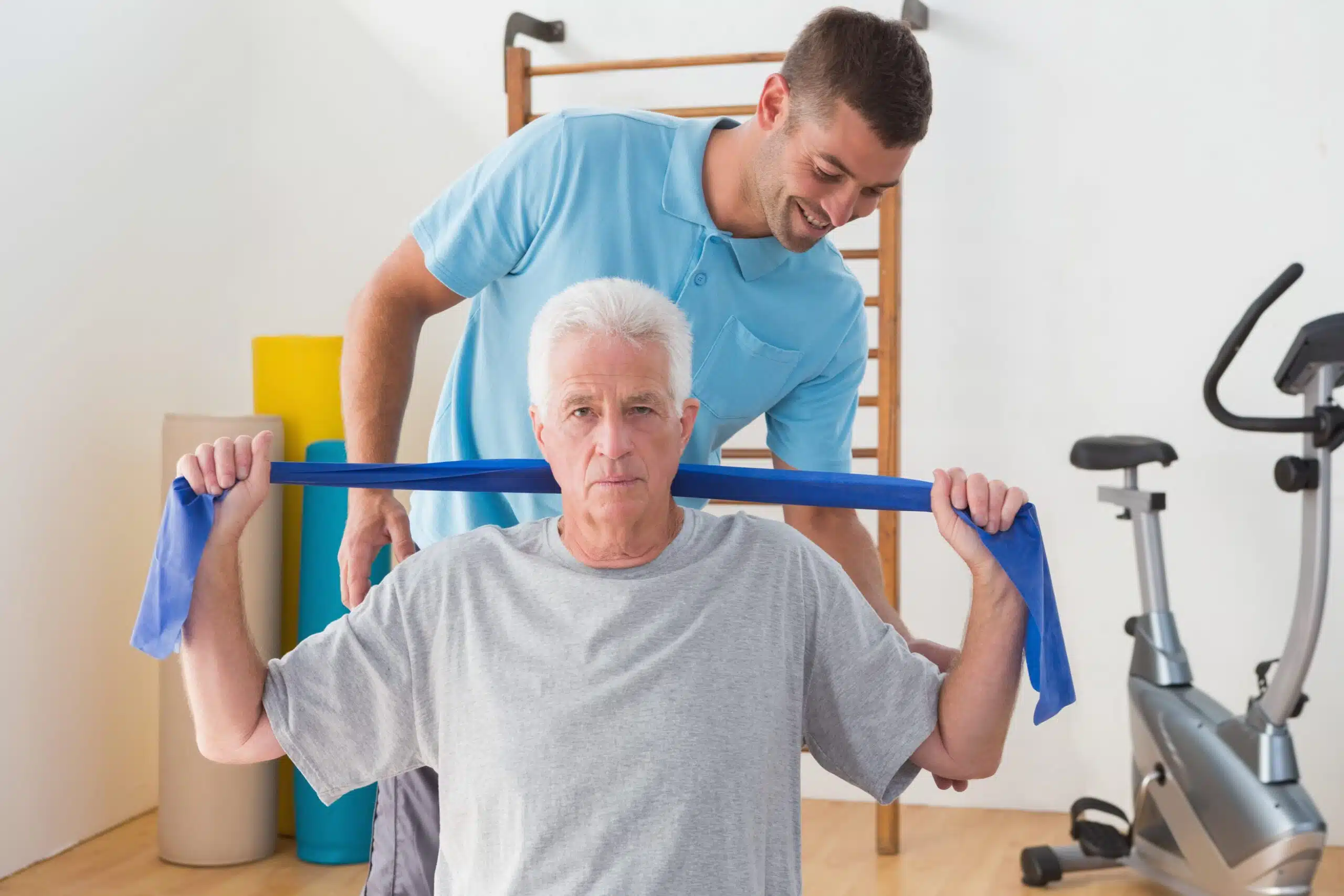Are you over 50 and concerned about losing muscle strength or bone health? Aging decreases muscle mass, but resistance training can help combat this issue. This blog provides practical tips for incorporating strength-training routines to maintain your physique and bone health as you age.
Keep reading to discover how to stay fit, strong, and healthy in your golden years!
Key Takeaways
- Aging can lead to muscle mass and bone density loss, but strength training can help slow down these effects.
- Strength training helps maintain muscle mass and promotes strong bones by putting stress on them safely.
- Regular strength training exercises like resistance training, weight-bearing exercises, and balance exercises can improve overall physical function and prevent obesity among adults over 50.
- Incorporating short sessions of strength training into daily routines using everyday objects as weights is an easy way to get started.
Understanding the Importance of Muscle and Bone Health Over 50
Aging has negative effects on muscle and bone health, making it crucial for individuals over 50 to prioritize strength training to maintain both.
The effects of aging on muscle and bone health
Aging can change our bodies. As we age, our muscles and bones may not be as strong. This is due to a loss of muscle mass and strength. It gets faster after age 65 for women and 70 for men.
Our bones may lose their density, too, leading to breaks or fractures more easily. But don’t worry! An active life and strength workout can slow this down.
The role of strength training in maintaining muscle mass and bone health
Strength training is a key part of keeping bones and muscles healthy. As you get past 50 years old, your body can lose muscle and bone health. Doing strength training helps to stop this loss.
It makes your muscles work hard, which keeps them strong. The same goes for your bones. Strength training puts stress on the bones in a safe way, causing them to stay dense and tough.
This helps lower the risk of cracks or breaks as you age. Some short-term changes even happen in the DNA of muscle tissue when you do strength training! So it’s clear: to help keep people over 50 strong, fit, and feeling great, regular strength training is very needed.
The Science Behind Strength Training
Strength training builds healthier bodies by increasing muscle mass and bone density, preventing sarcopenia, and improving overall physical function.
How strength training builds healthier bodies
Strength training is key to a healthy body. This type of workout makes your muscles work hard. Your muscles grow stronger when they handle weights or resist strain.
Every day, our bodies lose muscle mass. Strength training fights this loss and helps us keep our strength as we age. It also boosts physical performance – making daily tasks easier.
Eating protein at breakfast and lunch can pair well with strength training. The extra protein aids in preserving muscle mass and power.
Besides building strong muscles, strength training keeps you safe from diseases like diabetes and heart disease. It even lowers the chance of becoming frail with age. So not only does it make your body healthier, but it also upgrades your overall quality of life!
The concept of sarcopenia and its prevention
Sarcopenia is the term used to describe the loss of muscle mass and strength as we age. It’s a natural process, but it can lead to difficulties with mobility and an increased risk of falls and fractures.
However, there are ways to prevent or slow down sarcopenia. Regular exercise, especially strength training exercises focusing on building muscle, can help maintain muscle mass and strength.
By engaging in activities like weightlifting or resistance training, you can keep your muscles strong and functional for longer. So don’t let aging stop you from staying active and maintaining your health!
Strength Training and Obesity Prevention
Strength training is a crucial component in preventing obesity among older adults.
The link between strength training and weight management in older adults
Strength training plays a crucial role in weight management for older adults. As we age, our metabolism slows down, making it easier to gain weight. However, strength training helps increase muscle mass, boosting our metabolism and burning more calories throughout the day.
Additionally, strength training exercises like lifting weights or using resistance bands can build lean muscle tissue, which takes up less space than fat tissue. This means that even if the number on the scale doesn’t change significantly, you may notice that your body looks slimmer and more toned.
So by incorporating regular strength training into your fitness routine, you can maintain a healthy weight and improve your overall body composition and physical performance as you age.
Practical Strength Training Tips for Adults Over 50
Incorporate strength training into your daily routine and discover exercises that will help maintain strong bones and muscle mass. Read more to stay fit and healthy as you age.
Incorporating strength training into daily routines
To incorporate strength training into your daily routine, here are some simple tips:
- Start with short sessions: Begin with a few minutes of strength exercises each day and gradually increase the duration.
- Set a consistent schedule: Choose specific days and times for your strength training workouts and stick to them. Consistency is key to seeing results.
- Make it a habit: Treat your strength training as a regular part of your day, like brushing your teeth or eating meals. This will help make it a natural and enjoyable part of your routine.
- Use everyday objects: You don’t need fancy equipment to strengthen your muscles. Everyday objects like water bottles or cans can be used as weights for resistance exercises.
- Find activities you enjoy: Look for activities that incorporate strength training, such as gardening, cleaning, or playing with grandchildren. These activities can provide both physical activity and muscle-strengthening benefits.
- Join group classes or exercise with others: Working out with others can provide motivation and support. Consider joining a local fitness class or finding a workout buddy to keep you accountable and make exercising fun.
Exercises for maintaining strong bones and muscle mass
To maintain strong bones and muscle mass, here are some exercises you can incorporate into your routine:
- Resistance training includes exercises using weights or resistance bands to help build and maintain muscle mass. Examples include bicep curls, chest presses, squats, and lunges.
- Weight-bearing exercises stress the bones, helping to increase bone density and reduce the risk of osteoporosis. Walking, jogging, dancing, hiking, and stair climbing are all great weight-bearing exercises.
- Postural stretching and strengthening: Exercises that focus on improving posture can help prevent spinal changes associated with aging. Try incorporating exercises like shoulder retractions, neck stretches, and back extensions into your routine.
- Balance and coordination exercises: As we age, our balance can decline, increasing the risk of falls and fractures. Activities like tai chi and yoga can improve balance, flexibility, and coordination.
- Brisk walking: Walking is a low-impact activity that can be done anywhere and anytime. Aim for at least 30 minutes of brisk walking most days of the week to improve cardiovascular health and strengthen leg muscles.
Starting a Strength Training Program for Bone Health Fitness
Learn how to personalize your strength training program based on age and body weight, and discover the right exercises to improve bone health. Start now for a healthier, stronger future.
Considering age and body weight
As we get older, our bodies undergo changes that can affect our ability to engage in physical activity and our body weight. Age-related loss of muscle mass, known as sarcopenia, can lead to decreased strength and mobility.
This makes it important for adults over 50 to incorporate strength training into their fitness routine. Strength training exercises help build and maintain muscle mass, which can counteract the effects of aging on the body.
Additionally, maintaining a healthy body weight is also crucial for overall health and well-being. By combining strength training with a balanced diet and aerobic exercise, older adults can improve their body composition and physical performance while managing their weight effectively.
Choosing the right exercises
To ensure optimal results and safety, choosing the right exercises for strength training is important. Here are some factors to consider:
- Start with resistance exercises: Choose exercises that involve resistance against gravity or weights. This can include bodyweight exercises like squats, lunges, push-ups, and planks. Dumbbells, resistance bands, or weight machines can also provide effective resistance.
- Focus on all major muscle groups: Include exercises that target different muscle groups in your upper and lower body. This can help maintain overall muscle balance and functional strength. Examples include bicep curls, tricep dips, shoulder presses, leg presses, and hamstring curls.
- Gradually increase intensity: Start with lighter weights or lower resistance and gradually increase the challenge as you get stronger and more comfortable with the exercises. This helps prevent injury and allows for continued progress.
- Incorporate variety: Vary your exercises to engage different muscles and prevent boredom. You can try different variations of the same exercise or switch between different types of activities (e.g., using weights vs. body weight).
- Consider your fitness level and any limitations: Consider your current fitness level, any pre-existing medical conditions, or joint/muscle limitations when choosing exercises. Modify or choose alternatives if needed to accommodate these factors.
- Seek guidance from a professional: If you’re unsure about which exercises are suitable for you or want personalized guidance, consult with a healthcare professional or a certified fitness trainer who specializes in working with older adults.
Conclusion
In conclusion, strength training is crucial for maintaining muscle mass and bone health in individuals over the age of 50. Age-related decline can be minimized by incorporating resistance training into daily routines.
By staying active and engaging in strength-building exercises, older adults can enhance their physical abilities and overall health and wellness. Don’t let age limit you – start strength training today!
FAQs
1. Is strength training beneficial for maintaining muscle mass and bone health over 50?
Yes, strength training is highly beneficial for maintaining muscle mass and bone health as it helps to preserve lean muscle tissue, increase bone density, and reduce the risk of osteoporosis.
2. How often should I do strength training exercises?
For optimal results, it is recommended to engage in strength training exercises at least twice weekly, with a day of rest between sessions to allow muscles to recover.
3. What examples of strength training exercises can be done over 50?
Strength training exercises for individuals over 50 include squats, lunges, push-ups, bicep curls with dumbbells or resistance bands, and planks.
4. Do I need any special equipment or a gym membership for strength training?
No special equipment or gym membership is required for strength training. Many effective exercises can be performed using bodyweight or simple equipment like resistance bands or light dumbbells at home.

